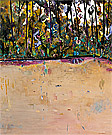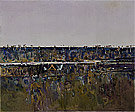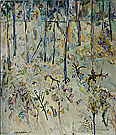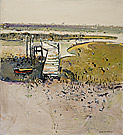Viewpoints 2
Fred Williams’s works of the 1970s became increasingly varied. His inventiveness is apparent in remarkable paintings like Tumblers 1967–68 and Stump II 1976 that challenge convention. The former refers to his London painting Acrobats 1955 and Francis Bacon’s works, and the latter relates to images of felled trees and concerns about the environment.
After Williams’s minimal works of the late 1960s undertaken in the studio, during the following decade he regularly painted outdoors in the bush in oil on canvas as well as gouache on paper, often in the company of other artists. This resulted in greater spontaneity and realism in some of the works.
Williams liked to return regularly to the same site in the regional Victorian landscape, getting to know it well. He would then paint what he described as the ‘summation oil’ back in the studio which was generally more abstract than the outdoor work.
The 1970s was a period when Williams experimented with a wide range of techniques and revolutionised his palette. Although he sometimes painted with luminous colour in his earlier works, they were, on the whole, more tonal than his vibrant, diversified approach later on. In 1972 he wrote in his diary: ‘I have a fierce desire to paint colour’.













